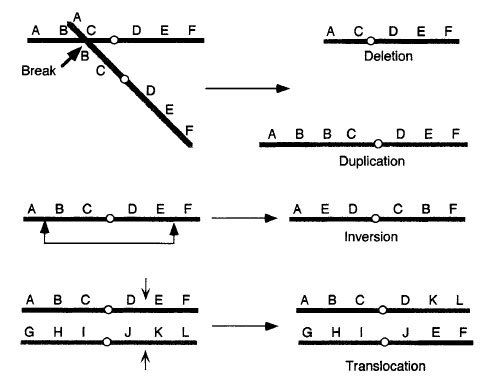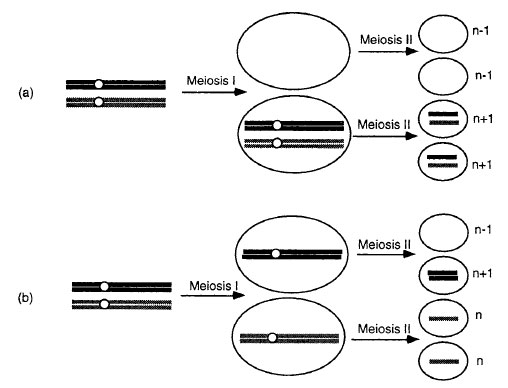Chromosomal Aberrations
Two types of chromosomal aberrations can occur in cells: changes in chromosome structure and changes in chromosome number. Structural changes include deletions, duplications, inversions, and translocations (Figure 6-2). Deletions are chromosomal changes in which one or more genes or chromosomal segments are lost. Duplications occur when one or more copies of a chromosomal segment are present on the same or different chromosomes. Deletions and duplications can occur in the same mutational event when two homologous DNA strands overlap, break at the same time at two different (nonhomologous) points, and then rejoin with the wrong strand. One of the strands will be missing one or more genes, and the reciprocal strand will have an extra copy of one or more genes. Inversions occur when a breakage in one of the chromosomes occurs and the segment rotates 180° before it rejoins. Translocations take place when nonhomologous chromosomes break and exchange segments. |
| Figure 6-2 Structural aberrations of chromosomes. |
In diploid (2n) organisms, there are two major types of chromosomal aberrations that are the result of changes in chromosome number. These are polyploidy and aneuploidy. Polyploidy results when cells acquire one or more sets of chromosomes beyond the "normal" number of sets. For example, triploids (3n) contain one extra set of chromosomes, and would therefore be sterile, since they cannot produce balanced gametes by meiosis.
 |
| Figure 6-3 Aneuploid gamete formation by nondisjunction during (a) meiosis I and (b) meiosis II. |
Aneuploids are the result of changes in the individual number of homologous chromosomes in a set. This usually results from nondisjunction during meiosis (Figure 6-3). The aneuploid condition that results in three copies of a given chromosome is known as trisomy (2n+1).




